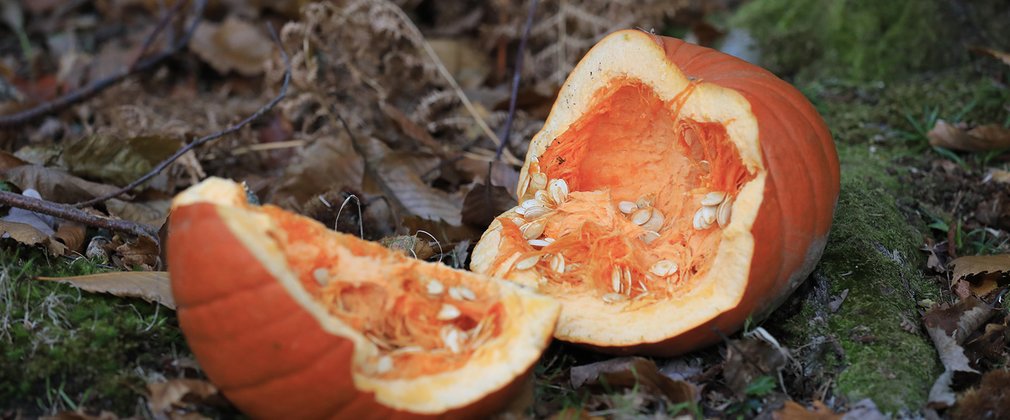
Dumping pumpkins in the woods is bad for wildlife says Forestry England expert
Pumpkins are a Halloween tradition, with approximately 24 million of them being sold in the UK each year to add to the excitement of the spooky celebrations! But what to do with your wonderful carved lantern once the spooky season is over? Forestry England are asking people to ignore online tips and tricks telling people to toss their pumpkins in the woods for wildlife and instead are offering some great alternatives.
Andrew Stringer, Environment and Forest planner at Forestry England says:
“We see many posts on social media encouraging people to leave pumpkins in the woods for wildlife to eat, but please do not do this.
“Feeding pumpkins, or any other food in the forest, to birds, foxes, badgers, deer, and boar can spread disease and make them unwell.
“Pumpkins are also often decorated and have things such as candles in them. Animals eating the pumpkins could then eat a foreign object and this could kill them.”
To protect our forest wildlife and to help reduce food waste, Andrew suggests using the flesh to make a delicious pumpkin soup or adding your discarded pumpkin waste to your compost to make a rich soil amendment for next year’s vegetable garden.
Andrew continues:
“There are lots of great ways to use your pumpkin after Halloween at home, and my favourites are to use the flesh to make a hearty soup, or to add to my compost. They are 90% water so are a great composting material, adding a great source of nitrogen and moisture to my compost bin each year.”
Here are some further ways you can give your pumpkin a new lease of life!
Make a pumpkin stock
By far the easiest and yummiest way to reuse that pumpkin is to eat it. Homemade pumpkin stock makes a rich base for pumpkin soup, or pumpkin risotto. You can make a simple stock with the pumpkin strings after you carve your Jack-o’-Lantern! Put all of the insides in a big stock pot with any other veggies you have on hand, like onion, carrots, celery, garlic, fennel, and mushrooms. Add a bay leaf or two, cover with water, and simmer for about an hour, stirring a few times.
Then strain out the veggies, and you’re done! You can use the stock right away, or freeze it to use later in tasty autumn recipes.
Find more delicious pumpkin recipes here.
Pumpkin bird feeder
Recycle the tough outer skin to make a temporary bird feeder for your garden. Simply cut the tough outer skin in half, pierce a hole in the top, gently loop wire through and use this to hang your pumpkin from a tree branch. Once hung, hold the pumpkin gently fill the pit with your favourite bird feed. Make sure to remove the feeder when the pumpkin starts to rot.
Make a pumpkin bowl
Looking for something a bit different to offer your treats in this Halloween? A pumpkinbowl will be a hit with any trick or treaters that come knocking. Simply clean your carved pumpkin, line with a cloth, and fill with sweets and chocolate!
Pass along your pumpkins
If you don’t want to deal with the pumpkins yourself, there are some places that will take them off your hands. See if you can donate leftover pumpkins to zoos, animal shelters, farms, or community gardens. They'll be grateful for the compost material or animal snacks.
Notes to Editor
- Images are available here. Please credit Nick Whittle/Forestry England/Crown copyright.
- Forestry England manages and cares for the nation’s 1,500 woods and forests, with over 291 million visits in 2022/23. As England’s largest land manager, we shape landscapes and enhance forests for people to enjoy, wildlife to flourish and businesses to grow. We are continuing the work we have already started to make the nation’s forests resilient to climate change and by 2026 we will:
- create at least 6,000 more hectares where we integrate wilding activities in our productive forests
- increase the diversity of visitors to the nation’s forests and have one million hours of high-quality volunteer time given to the nation’s forests
- plant at least 2,000 hectares of new, high quality, predominantly broadleaf woodlands
For more information visit forestryengland.uk. Forestry England is an agency of the Forestry Commission.
Media contact
Rebecca Ulewicz, Media Relations Officer | media@forestryengland.uk
